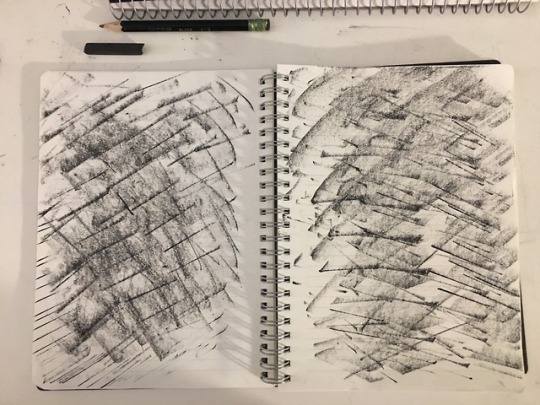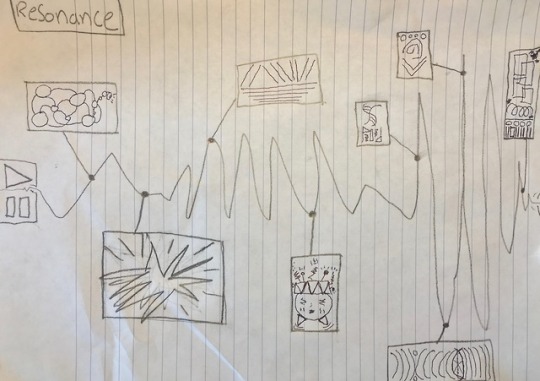Video
youtube
Yet another (and final) posting of the Elfen Lied song, this time it’s done on a homemade music box! In the show, the music box which played “Lilium” had a deep connection with the characters. This version sounds slightly different from the original music box example that was featured in the show.
0 notes
Text
J-Lin Concert: Kevin Beasley Exhibit at The Whitney
On March 2nd, I went to the Whitney for the “A view of a landscape” exhibit featuring musician J-Lin.
As you first enter the Kevin Beasley exhibit, you immediately can see works of art lining the hallways, these art pieces were collages that featured many fabrics that would have been created by slaves in the American South during the 1800′s. The collages also featured a wide array colors, many were dyed cotton. The main object on display was a cotton gin, used from the 1940's until the way 1970′s. The cotton gin was encased in glass and had robotic arms that had microphones attached to them, capturing the sounds of the gin and using it to create the noises used during the J-Lin show. You could not hear any noise coming from the gin, so it had to be in a sound-proof enclosing.
The performance by J-Lin was an amazing experience. When you first enter the room of the performance you notice the lighting is very dim and the back wall had lights that created the color spectrum. In center stage was a single macbook computer running ableton connected to a synth. Behind the computer was this huge, nasa-spacecraft control center looking machine. This machine was responsible for picking up the sounds of the cotton gin and using it to power the sounds that J-lin was going to use during her improvised performance.
As J entered the room and began setting up, she noted that she might make some weird faces/expressions during the show and that it’s totally normal and she’s just “feeling” it. She also warned us that we might not like somethings and that certain areas of her work might get very loud. All in all, she seemed like an extremely honest and down-to-earth person just from her statements during the intro. The music she produced during the show wa energizing and engaging. Every piece was quite different from the last. Some sounded very ambient and loud, which caused the floor beneath us to literally tremble like an earthquake. Other pieces sounded like Trap music and new age electronica. And her final piece (which was my favorite) used samples from people talking (possibly from movies/shows) and from old-school hip hop beats to create a unique sound that juxtaposed the 90′s rap sound with modern day sampling and beat making. In conclusion, I really enjoyed the experience as a whole and it introduced me to many new aspects of sound productions, like the literal translation of a cotton gin into unsable sounds, and helped me more appreciate the work of modern day beat makers. I also developed an interest in wanting to learn how ableton works after watching the performance, the way you can sample and create new beats/tones on the spot really resonated with me and piqued my interest with improvised performances.
0 notes
Photo
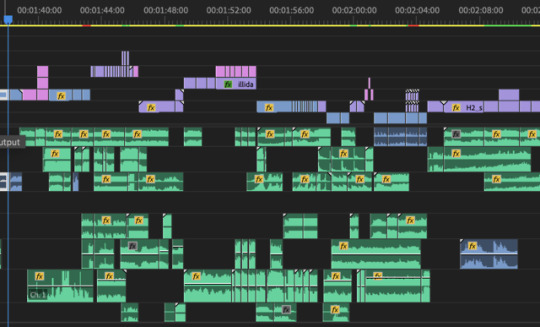
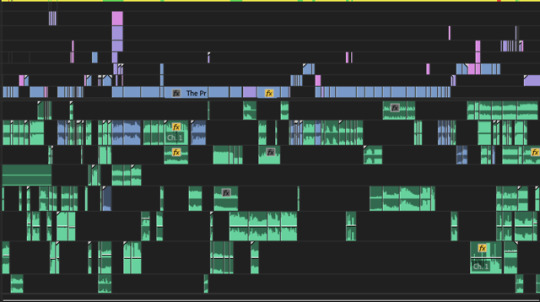


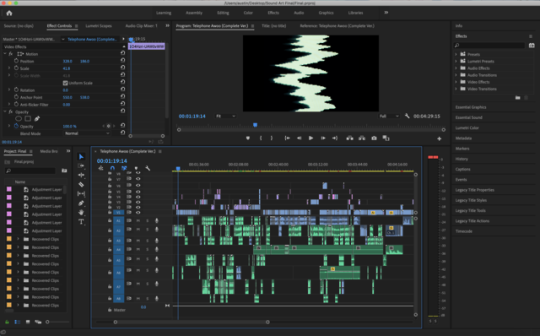

Some more images from my project’s work panel.
Green = Sound samples
Blue = Video clips/Video sound samples
Purple = Gifs/Images
Pink = Adjustment Layers
0 notes
Photo
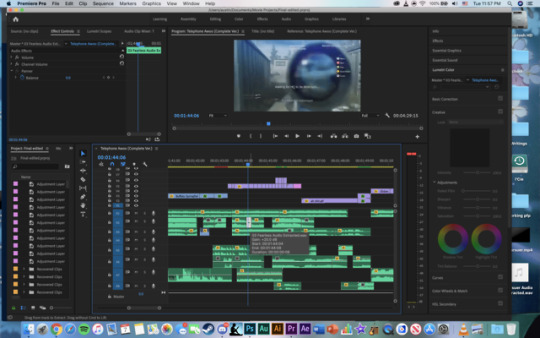
A still from my project’s panel. This shows the sound file used to create the “gunshot” sound of the sniper.
0 notes
Video
youtube
Final: Is This Sound Art?
Play at 0.95x for best results.
-Edited ver. is up on channel-
0 notes
Text
Final - Is This Sound Art?
My final is called “Is this sound art?”
It is a collage that combines many concepts that we learned of in class. From John Cage’s take on sound, noise, and silence to the late 20th century masters of sampling all the way to the modern day vaporwave and glitch art scene.
I was influenced by dirt style, vaporwave, plunderphonics, Ryoji Ikeda, glitch music and art, acousmatics, Christian Marclay, James Tenney, Hugo ball, Amacher, and the internet as a whole. The visual (skit) format was influenced by Forcefield and early Fluxus performances.
My Piece very much has a lot to do with comedy and internet/digital culture. I wanted to make something that peeked back at my life so far and all the things I enjoyed growing up with (and still do today). The video is done in skits, sort of like a “Robot Chicken” of sound art. It is called “Is This Sound Art?” because I have a sense of humor and mainly because that is a very thing I questioned myself with while making this piece. It starts with me receiving a VHS that contains a collection of my past, told through various things I’ve enjoyed throughout my life, like video games, music, internet memes, anime, tv, and movies. It begins and ends with the tape, and the video in which I am watching begins and ends with heavy distortion. I very much enjoyed working with both Premier Pro and Adobe Audition to create this project; I learned many new skills and hope to improve my editing prowess in the future.
When creating the sound pieces, I later introduced gifs and stills that complimented what was going on, later I incorporated clips from movies and eventually one thing led to another and I was simultaneously making sound art and videos that were edited around the sounds. Through responding to one thing the other came along shortly. Most (if not all) the videos used are replaceable with other clips or stills if edited properly. The sounds created gave me a vision of the visual aspects that would better portray the very impact of what I intended the sounds to have in the first place.
I will post images of my project panel to help show the actual process involved in creating this piece.
Process:
One of the thing I didn’t get to go over in detail in class was the process and the lengths in which I went to to find fitting video clips to match my sound sample pieces.
Note: 95% of the video clips used did not retain any of their original material in terms of sound or were edited/transposed with other sounds!!!
(a perfect example of this is found at the 1:44-1:45 min mark in my video, in which you see an M40A3 sniper from CoD4 go off and seemingly hear the sound of a gunshot to go with it. This is in fact not at all the sound you are hearing (or a gunshot noise at all!), instead, I used a section of the recording of “Fearless” by Pink Floyd and added a reverb effect in Adobe Audition that makes it sound void and distorted to make the effect. (the same song is used at 0:58-1:01, and football chant section at 1:14 and 2:30 respectively)
Also, many video clips were edited to make it look like people/characters are speaking words in which my sound collage sample is saying, but they are just either examples of pure chance, like at the 1:17 mark, where it looks like you see The Hound from Game of Thrones singing “I’m Tickled Pink” by Jack Shaindlin. (He is actually singing....this.) Or they were intentional morphed into looking like they spoke the word, like the obvious one at the 1:20 mark.
I started my process by mingling together sounds and songs samples from various medias and in some cases spoken word. I then, completely separately, compiled a massive load of videos from various sources on the internet, and also recorded some videos myself, of myself, and from footage of video games recorded by myself. I then tried my best to fit my sound examples together to form separate “skits”, then I did the daunting task of editing the videos together in a way to make it look like it all fit together somewhat naturally!
Description (as seen on YouTube):
This is a project that I made for my sound art class! It combines themes we learned like plunderphonics, collage, acousmatics, and sound sampling to create something that is meant to be a revision of my past. I explore things that are important to me through: Internet culture + memes, video games, anime, TV, movies, music, and more! My main inspirations were glitch art, vaporwave, dirt style, and the core essence of what it is to be a sound sampler. I always ask myself: What is sound art? And to no avail, i get myriad of answers and descriptions. I created this piece to challenge the very question of what makes something "sound art" and what makes it just some plain old memified video found on the interwebs. This took me 3 days straight to create and I hope you'll enjoy!!
Samples: [Emboldened = Used for longest period(s)]
Sounds - From the beginning (some are used multiple times with varying degrees of effects/distortion/application)
CD Scratch sound effect (edited - later used unedited)
VHS Tape Hiss (used throughout VHS tape and distorted at beginning)
Voice Recording - “What is Sound Art?”
The Boredoms - Budokan Tape Try
dubbed.wav - (voice sample)
Footsteps recording - by me
Ambient noise of city recording - by me
Steven Connor: Photophonics - excerpt as text to speech
Lighter flick sound recording - by me
VHS Tape Insert sound
Static effect 2
Paper Rad - Welcome to my site
Hitting my TV recording - by me
Come on, what is this shit? recording - by me
Glitch effect(s) (I used about 7 of these, I will list the #’s used)
John Cage - Music of Changes
Me playing Violin in response to music of changes
VHS Static Noise
THX Sound
Glitch effect 1
Glitch effect 2
20th Century Fox Intro - Recorder Edition
Glitch effect 3
Glitch effect 4
Highly distorted pokemon noise
Error noise - subtle
Omae wa mou shindeiru (NANI?)
Chewbacca's Roar
Saya No Uta - Song of Saya I (Video Game/Visual Novel)
Sonic Youth - Green Light (barely heard underneath Song of Saya during seq.)
Junko Ohashi - Telephone Number (first awooo)
Windows computer error noise
Warren Zevon - Werewolves of London (second awoo)
My cat (Luna) meowing - recording by me
Pixar Animation Intro (used bounce sound)
“This Isn’t Sound Art!” - Voice recording of myself
Naruto - Sadness and Sorrow
WTF Am I Doing? - Text to speech (text to sing!)
“The thief was smart” from the YouTube Video, “Professor pwnage”
The Velvet Underground - All Tomorrow's Parties
Pink Floyd - Fearless (Highly reverberated/distorted during 0:58-1:01, and the sniper scene(1:44); I also used the football chants found near the end of the song at 1:14 and 2:30)
“What I am calling poetry is often called content” - Quote from R Murray Schafer - The Soundscape reading from class, Text to speech
Big Bill Hell’s (Fuck You Baltimore! excerpt)
Cheering crowd (stock sound)
Glitch effect 5
Korg-M1-Windbells MIDI sample file
Birds chirping (stock sound)
ORA ORA ORA - from JoJo’s Bizarre Adventure (Anime)
“Because life doesn’t happen...But i’m making sound and that’s the important thing” Quote from filthy frank video.
Glitch effect 6
Helicopter.wav (stock sound) (used during Monty Python: Upper Class Twit of The Year part) - This is worth a watch :D
Leeroy Jenkins - Popular Meme from the video game: World of Warcraft
Glitch effect 7
I’m Tickled Pink - Jack Shaindlin
Vinyl Crackling sound sample
Hey! Listen! - Navi from the video game: Zelda
Asuka saying “Ehh”- From the Anime: Neon Genesis Evangelion
Cpt. Beefheart - Veteran’s Day Poppy
Radiohead - Fitter Happier
Avengers: Age of Ultron dialogue + ambience
ELO - Mr. Blue Sky
“Too many F****** People” - Recording of myself
Beeping censor effect
ARA-ARA
Who the hell are you?
Frantically writing - sound recording by me
Guided By Voices - I am a Scientist
The Grateful Dead - St. Stephen (used underlapped w/ “I am a scientist part-distorted into chime like sounds, also used at 2:01 more clearly)
Porky Means Business - Track from the video game: Earthbound
Call of Duty 4 Intro sound effect
“Aw shit, here we go again” - (GTA: SA Meme)
Nintendo Gamecube startup noise
Super Mario Bros. Theme
Dropping coins - Recording by me
Led Zeppelin - Going to California
Clannad OST - Roaring Tides II (Anime song)
Robert Johnson - Hellhound on my trail (used at 1:58-9)
Steins;Gate Opening (Anime; Used glitch sound from beginning)
Truck backing up beeping sound
Ally Kerr - The Sore Feet Song (used at beginning of the Halo 2 sequence in juxtaposition of Led Zeppelin’s “Going to California”
George Carlin - Advertising and Bullshit (”I call this piece...Advertising”)
Guided By Voices - Wonder Boy Poet (briefly behind “The Sore Foot Song”)
Door Stuck! Door Stuck!!! (Used video as media and mic chatter as audio)
Yawning - recording of me
Powerful goku vs the pursuer
To Zanarkand - Final Fantasy X
Lelouch’s Checkmate (Dub)
Galaga sound effects
TV static sound effect
Nautical Almanac - sounds from clip (further distorted/warped)
Mac death chime
Windows (PC) crashing sound
USSR Anthem played on Nokia 3310 phone
ZUNpet Test (Touhou video game music emulator)
Popotan Intro (eroge) (source of Caramelldansen meme dance)
“Help me” - Voice recording by me (reversed)
Rain ambiance stock sound
“Aw Shit” - Voice recording by me
Toto - Africa
Shion Laughing Insanely (Anime: Higurashi [a personal favorite])
The Doors - How To Touch The Earth (I AM THE LIZARD KING!)
VHS eject noise
VHS getting destroyed video
0 notes
Text
Exercise #11
R. Murray Schafer, in his text The Post-Industrial Soundscape, refers to the new noises of post- Industrial Revolution with lists that show typewriter sounds, sewing machines, and food canning facilities sounds as creating an environment where the sounds people hear have become music. Schafer writes that with the Industrial Revolution, the Doppler effect became apparent and resulted as sounds waves with different pitches and the high sound speeds bunches up. The Industrial Revolution, allowed the effect to be discovered and ushered in new generations of people where these new sounds became the norm allowing them to sneak into the music of generations to come. As the decades past, music was changing and combining these industrial noises with the sounds of instruments and voices creating a new type of music.
By the late 1970s, avant-garde movements like No-Wave, which hit the New York underground with experimental sounds was heard in retaliation to the punk sounds of earlier in the decade that took from rock-and-roll. No-Wave groups found the punk music too sterile and this No Wave movement started to experiment to create something totally new and not taken from rock and roll. During this time, Jacques Attali wrote a book, Noise: The Political Economy of Music. This book, written in 1977, talks about how music has gone through four stages. His last stage is “Post-Repeating”, yet Attali leaves this phase more open to interpretation. The No-Wave sound easily fits with the ideas of mixing and sampling with the use of electronics, so basically it could be considered a part of the last stage of music. As this experimentation of sound spread, a new genre would come to include the sounds of the industrialized world.
Three years after the publication of Attali’s book, many new sounds were popping up around new York City and other large cities. These groups were the bi-products of the No-Wave movement. There was New-Wave, Alternative, Post-Punk, Synthetic pop, and heavy metal. There were also movements that were the antithesis of some of the sounds of the past, but fit with its No-Wave origins of using noise as music. One type of “metal” had to do with the Industrial Revolution two hundred years before, this new type is called Industrial Music. This took the sounds from steel, iron, machines and other industrial sounds and created a new type of music. Groups like Test Dept. with Total State Machine doing a live atonal in Berlin in 1985 and then using an archive video showing workers at a factory with welders and the group yelling comments in background. This genre really caught on in Germany and German groups sprung up like Einsturzende Neubauten’s “Halber Mensch” which means half-man, “created noise” about how man is now only half human and the other half is a machine for the state. The track is the band chanting lyrics in German with noises in the back. The video shows items made of metal, like an empty grocery cart. The Japanese took the video and subtitled with Japanese characters and redistributed it. Other groups that yelled lyrics of despair with musical instruments combined with electronics and metal objects was Fad Gadget with “Collapsing New People” in 1984 with heavy electronics combined with chef’s spoon and pots and Skinny Puppy from their album Mind: The Perpetual Intercourse, (love this name), from 1986 which uses aggressive industrial samples with the band speak-singing lyrics. These two tracks sounds musical with the way the sounds were compiled when comparing with some of the other groups that were more strict with their productions. One thing that was obvious with this new Industrial genre is the abrasive and confrontational words and sounds that reflected their nihilistic worldview, connected with the trappings from the power and money that came from the Industrial Revolution. The anger against the industrialized machine was strong.
0 notes
Video
youtube
“Lavender Town” is an 8-bit song made for the game “Pokemon Red and Green” (Release as “Red and Blue” in the US). It is the song that plays in the village “Lavender Town”. It uses sharp chiptune sounds. This is the original version, which caused the game to be recalled from shelves due to high-frequency pitches that apparently cause harm to underdeveloped ears in children in Japan. In the game, it is the town where the graves of all the Pokemon are located, giving it that eerie sounding track. Legends arose around on the internet in the late 2000's that the song actually caused children to commit suicide due to the depressive nature of the tune, the high-pitch frequencies, and the report that there was a spike in suicides between the ages of 7-12 shortly after the release of these games in 1996. Which lead it to become a creepypasta.
0 notes
Video
youtube
"Flowering Night” from the video game “Touhou 9, Phantasmagoria of Flower View”. Original was done in MIDI and WAV formats. This is it done on a phone pad.
0 notes
Text
Ex 11 - Final Proposal
For my final I am planning on doing a sound/music/noise collage similar to my midterm but with the addition of some visual medium to go with it. Im leaning towards samples of various forms of media (film,tv,animation,gif,etc.) like how I form the audio aspect. I’m going for a longer piece than my midterm and I don’t want to have it be about my daily schedule like what was done in the midterm. I still want it to be personal and reflect something from my life or psyche.
0 notes
Text
Exercise #10 - On Yves Klein
When discussing visual artists who work with sound in class, early on we came across the French artist Yves Klein. Born in Nice to a family of painters, from an early age he was widely exposed to and learned many different kinds of art styles, from figure drawings to abstract expressionism. At age 25 Yves traveled to Japan and became the first European master at judo, reaching the rank of yodan (4th degree black belt). He laster established himself in the art world a year later, after moving to Paris, France.
His art style originally focused on monochrome works, which led to “Klein Blue”, which became his staple and put popularised the monochrome style as an artform. The piece that we covered in class, “Symphony Monotone Silence” (1960) was the first instance of his visual art coming into contact with sound. The piece was part of Yven’s “Anthropometries” series of painting which comprised of women painting themselves head to toe in Klein’s signature blue color. The women would then walk into a huge canvas encompassing the wall and create a piece of art from the blue body shapes that were left over.
In Anthropometries, while the women were coating themselves and creating the figure paintings a seated violin ensemble would be playing alongside them. In general, I think the main concept of the piece in intriguing, but, as much as I like Yves and his work, I have some problems with his “Symphony Monotone Silence”. The first is most clear to me; What makes his work an example of sound art at all? If you are born wealthy and already have one foot into the art world just by the luck of what kind of family you were fortunate enough to birthed to, should we always assume that these kinds of people always be “special”, in that we give them special privileges and concessions for what they are trying to achieve/become? In all honestly he just got a bunch of attractive females to get nude and paint themselves blue and walk into a wall, sounds like a great sight for a bunch of horny, wealthy men who have no sense of which direction to throw their money at. The whole thing also feels so fufu and haughty that it’s hard to really see past the suited violin ensemble playing horribly. This bring me to the final critique of “Symphony Monotone Silence”, which is the sound aspect, there appears to be an ensemble of violinists and a flautist during the painting, but you can’t hear anything but a looping drone that sounds like a pre-recording of one or two instruments with the ensemble just there as a trick/joke. I feel like the whole ensemble itself is unnecessary for the monotonous tone produced and would be stronger if it was either more abstract, ambient, or as the title of the piece suggested, SILENT all together.
0 notes
Video
youtube
A perfect example of a modern day fusion of Vaporwave aesthetics with a chillwave and Lo-Fi sound. The entire video is an excerpt from the anime Cowboy Bebop (One of the best Animes of all time) and the song uses voice from the show and incorporates in into the track. The Vaporwave alterations are there, complete with the 90′s CRT scan effect, muffled voice quality, and fuzzy picture to give that 1990′s look and feel. The video was edited fluidly, to make it feel like it is an extension to the song.
0 notes
Text
Exercise #9
John Oswald and Paul D. Miller both have used recorded music and altered it to create another sound. Oswald takes this recorded music and plays it backward, makes it slower or faster as well as takes sounds and redistributes them creating another musical piece that is obviously identifiable. He calls this “plunderphone”. Miller takes his DJ skills and combines music, takes recorded songs and manipulates them by lengthening with added instrumental or sound tracks to change the music, yet keeping the utilized arrangement attributed to the original piece of music intact to some extent. I feel that utilizing another’s composition but changing it to create another piece of music is not plagiarism, depending on the art piece created. Obviously, there should be changes that truly create a different type of music. In this way, I believe that composers, such as Oswald, did not plagiarize. Oswald wrote that there was a fine line between recreating a piece from an existing one to copying it without unique changes. Oswald said, “The plundering has to be blatant though. There’s a lot of samplepocketing, parroting, plagiarism and tune thievery going on these days which is not what we’re doing”. Sampling is what Miller does. He takes bits of songs and puts them together with other songs or sounds from electronic equipment. I believe that DJ’s should have the artist’s approval to do this because it may go against copyright laws and may be seen as plagiarism. Although when the DJ is not taking the credit for the music, this alters my view a bit. Miller believes that by adding computerized sounds, the music is altered enough to be a new creation. Is re-purposing music through technology a new creation? This is the fine line that Oswald spoke about.
I do believe that taking a piece of sound art or music and changing it to create a new type of sound or a new art piece altogether is not plagiarism. If it were, then every copy of the “Mona Lisa” painted by other artists through the centuries must be plagiarism too. But I do believe that when barely altering a piece and calling it a new product is stealing creativity from another person.
0 notes
Video
youtube
As Vaporwave became more and more popular, elements from it were used in creating new genres. Lo-Fi hip hop beats (To study/relax to) has infiltrated YouTube and can be seen everywhere. Chillwave and Synthwave have also seemingly merged with Vaporave in the late 2010′s to create a lot of popular music. This is an example of a lo-fi hip hop track that uses elements found in Vaporwave (Aesthetics, depression/loneliness, anime, looped gif, nostalgia)
0 notes
